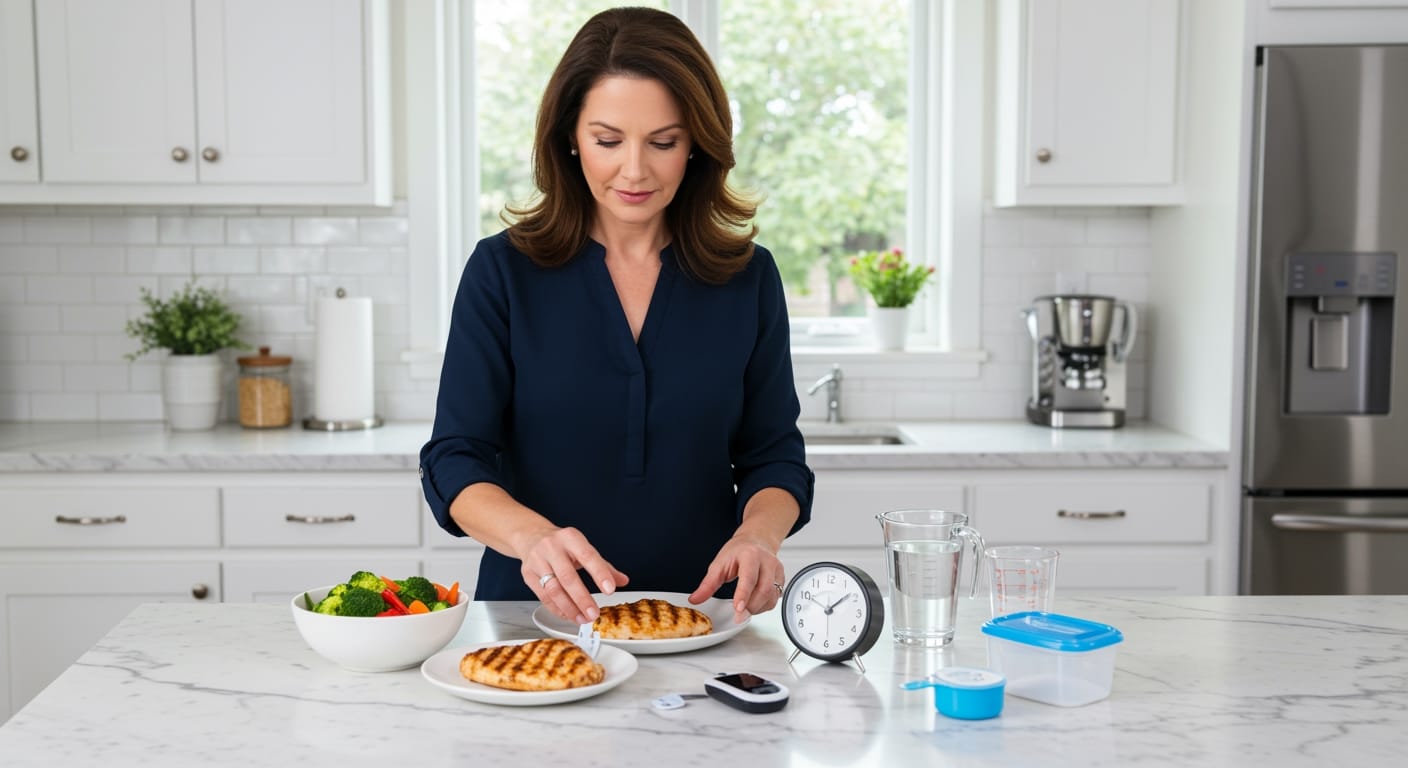✪ Key Takeaway: Three balanced meals work better than six small ones for most diabetics because they provide more stable blood sugar control.
Introduction
Your doctor told you to eat six small meals a day to control your diabetes.
You might be wondering if this advice actually works or if there is a better way to manage your blood sugar through meal timing.
Hi, I am Abdur, your nutrition coach and today I am going to explain whether diabetics should eat six small meals or three large ones, and help you discover which approach gives you the best blood sugar control for your specific situation.
What Does Science Say About Meal Frequency?
Research shows that meal frequency affects blood sugar differently than most people think.
A study published in the American Diabetes Association journal found that people with type 2 diabetes had better glucose control when they ate three meals per day compared to six smaller meals.
The three-meal group showed lower average blood sugar levels and needed less medication to maintain control.
Scientists discovered that frequent eating keeps your digestive system constantly working.
This continuous digestion process can lead to insulin resistance over time because your body never gets a break from processing food.
Your pancreas works harder when you eat every few hours, which can worsen diabetes symptoms in the long run.
✪ Fun Fact: Your body takes 3-4 hours to fully digest a balanced meal and return blood sugar to baseline levels.
Why Do Doctors Recommend Six Small Meals?
The six small meals recommendation comes from outdated thinking about diabetes management.
Doctors used to believe that eating smaller amounts more frequently would prevent blood sugar spikes.
This theory made sense on paper but failed to consider how your body actually processes food throughout the day.
The problem with frequent eating is that it keeps your insulin levels elevated constantly.
Even small meals trigger insulin release, and when this happens six times daily, your cells become less responsive to insulin.
Many healthcare providers still follow this old advice because it seems logical and safe.
However, newer research shows that giving your digestive system longer breaks between meals actually improves metabolic health and blood sugar control.
✪ Pro Tip: Track your blood sugar for one week with each eating pattern to see which works better for your body.
What Are the Benefits of Three Larger Meals?
Three balanced meals provide better blood sugar stability than frequent small meals.
When you eat three times daily, your body has time to fully process each meal and return to baseline glucose levels.
This eating pattern allows your insulin sensitivity to improve between meals, making your medication more effective.
Larger meals also help you feel more satisfied and reduce cravings throughout the day.
You spend less time thinking about food and planning snacks, which reduces stress and improves your relationship with eating.
Three meals make it easier to control portions and track your carbohydrate intake accurately.
This approach also fits better with social situations and family meals, making it more sustainable long-term.
✪ Note: Always consult your healthcare provider before changing your meal frequency, especially if you take diabetes medications.
When Might Six Small Meals Work Better?
Some diabetics do better with six small meals, but this depends on specific individual factors.
If you take certain diabetes medications that cause low blood sugar, frequent meals might prevent dangerous drops in glucose levels.
People with gastroparesis, a condition that slows stomach emptying, often need smaller, more frequent meals to manage their symptoms.
Some individuals with severe insulin resistance initially respond better to smaller meals while their body adjusts to treatment.
If you have a history of eating disorders or struggle with portion control, six small meals might help you develop better eating habits.
However, these situations are exceptions rather than the rule for most people with diabetes.
The goal should always be to work toward a more natural eating pattern that supports long-term health and blood sugar control.
✪ Pro Tip: Start with your current pattern and gradually adjust meal timing while monitoring your blood sugar response.
How Should You Structure Your Three Meals?
Each of your three meals should include protein, healthy fats, and complex carbohydrates in balanced proportions.
Aim for 20-30 grams of protein per meal to help stabilize blood sugar and keep you satisfied between meals.
Include fiber-rich vegetables and whole grains to slow carbohydrate absorption and prevent glucose spikes.
Space your meals 4-6 hours apart to allow complete digestion and give your insulin levels time to normalize.
Make breakfast your largest meal and dinner your smallest to align with your body natural insulin sensitivity patterns.
Avoid snacking between meals unless you experience genuine hunger or low blood sugar symptoms.
This structure helps your body develop a predictable rhythm that supports better metabolic health and easier diabetes management.
✪ Fun Fact: Your insulin sensitivity is highest in the morning and lowest in the evening, making breakfast the best time for larger meals.
The Bottom Line
Three balanced meals work better than six small ones for most people with diabetes because they provide more stable blood sugar control and improve insulin sensitivity.
As I always tell my clients, the best eating pattern is the one you can follow consistently while maintaining good blood sugar control.
I would love to hear about your experience with different meal frequencies and any questions you might have about managing diabetes through nutrition in the comments below.
References
At NutritionCrown, we use quality and credible sources to ensure our content is accurate and trustworthy. Below are the sources referenced in creating this article:
- Diabetes Care Journal: Nutrition Therapy for Adults With Diabetes or Prediabetes
- Clinical Diabetes Journal: Five Evidence-Based Lifestyle Habits People With Diabetes Should Adopt
- Better Health Victoria: Diabetes and Healthy Eating
- PMC Research: Meal Timing and Diabetes Management





